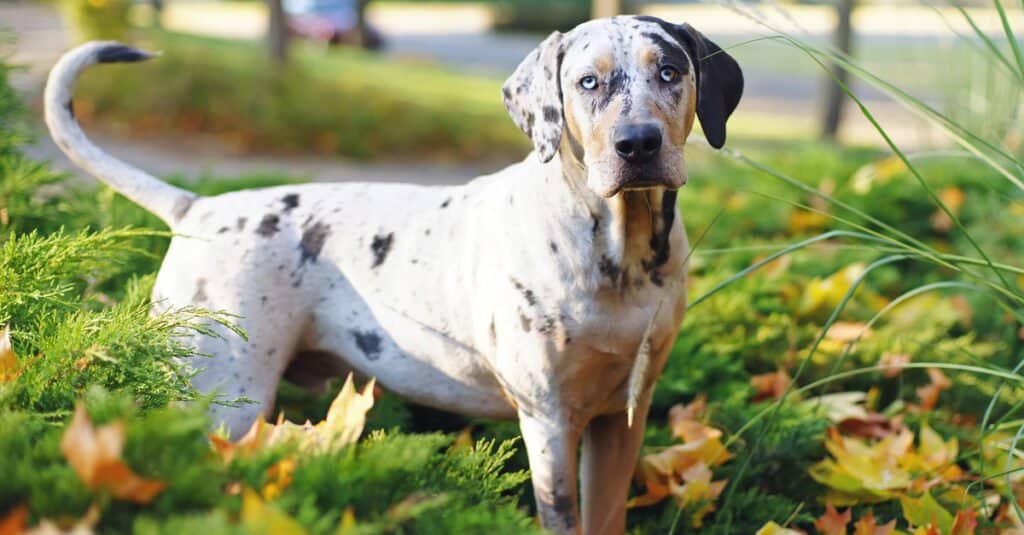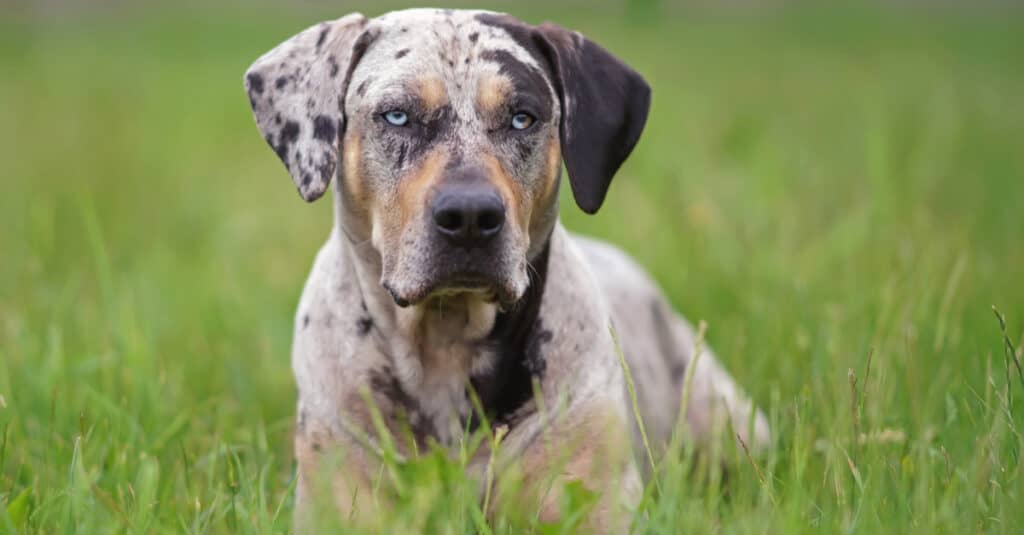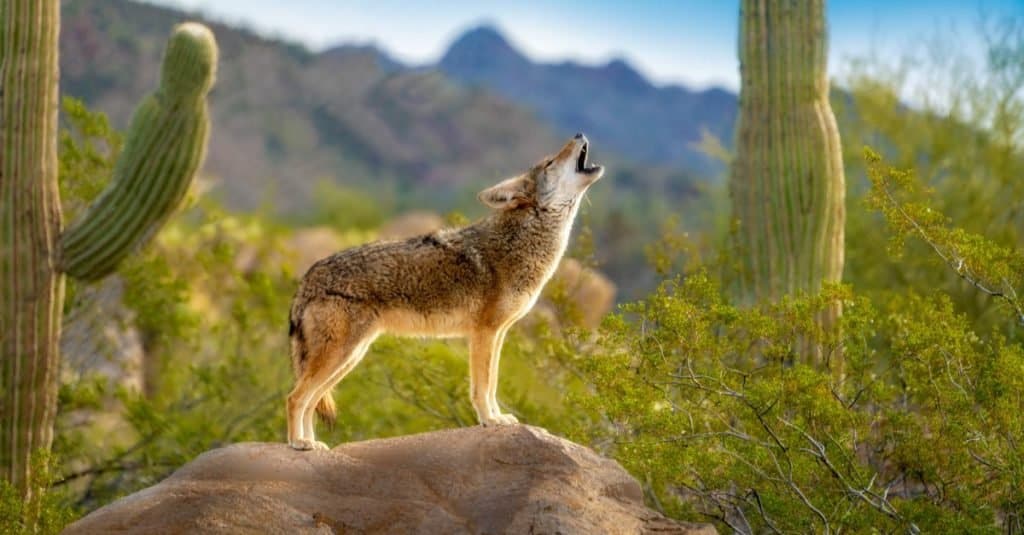The Catahoula Leopard Dog and the coyote are two very different species, but we’re sure you’ve wondered how you can tell them apart at least once in your life.
No worries! We’ve got this sorted out for you! This insightful article highlights what makes these two special, tells you how to differentiate them, and advises you on whether you should consider choosing them as pets or not.
Comparing Catahoula Leopard Dogs vs Coyotes

| Catahoula Leopard Dog | Coyote | |
|---|---|---|
| Size | 22-26 inches 40-110 pounds | 24-26 inches 18-44 pounds |
| Colors | blue merle, red merle, brindle, solid color | Light gray and red or fulvous mixed with black and white |
| Coat | Short to medium coat; smooth | Short and soft underfur; long and coarse guard hairs; northern subspecies have a longer and denser coat |
| Life Expectancy | 10-14 years | 10-15 years Almost double in captivity |
The Key Differences Between Catahoula Leopard Dogs and Coyotes
The key differences between Catahoula Leopard Dogs and coyotes are appearance, diet, health issues, and lifespan.
Let’s explore these differences in detail!
Catahoula Leopard Dog vs Coyote: Appearance

The Catahoula Leopard Dog measures roughly 22-26 inches long.
©Eudyptula/Shutterstock.com
Size
The Catahoula Leopard Dog and the coyote have approximately the same height – somewhere around 22-26 inches. They differ from each other in terms of length and weight.
The Catahoula Leopard Dog measures roughly 22-26 inches long and weighs between 40 and 110 pounds, depending on if we’re talking about a male or female dog. Male dogs can weigh as much as 110 pounds, while female dogs weigh up to 90 pounds.
On the other hand, the coyote is much longer – it measures 24-26 inches. When it comes to weight, the coyote is not as heavy as the Catahoula Leopard Dog. The average weight of a male coyote is 18-44 pounds, while that of a female coyote is 15-40 pounds. The northern subspecies of coyotes usually grow larger, while the southern subspecies have an average weight of 25 pounds.
Coat
The Catahoula Leopard Dog has short, smooth hair that varies in color. Its coat is usually red merle, blue merle, or brindle. There are also Catahoula Leopard Dogs with solid colored coats, but they still have small patches of other colors, such as white spots on their faces. The Catahoula Leopard Dog can have brown, green, blue eyes, or a combination. It has a well-built appearance and is extremely resilient.
The coyote has a luxuriously-looking coat consisting of short and soft underfur and long and coarse guard hairs. The northern subspecies have a longer and denser coat. The coat color varies depending on where the coyote is located. But they usually have a mixture of gray, brown, and sometimes yellow on their body’s upper parts. Their stomach and throat are white, and the parts around their muzzle and the feet are red-brown. The coyotes that live at high elevations have a darker coat than those living in the lowland areas.
Catahoula Leopard Dog vs Coyote: Diet

The Catahoula Leopard Dog requires a high-quality diet that will help prevent certain health issues.
©Eudyptula/Shutterstock.com
Since the Catahoula Leopard Dog is a breed you can choose as a pet, you should know that it requires a high-quality diet that will help prevent certain health issues. For example, food rich in calcium is mandatory for the Catahoula Leopard Dog even from its “childhood” because the breed is prone to developing hip dysplasia. You’ll have to feed your dog with puppy food until it’s two years old.
Moving on, while you’re switching to adult food, you have to consider that the Catahoula Leopard Dog is a large and active breed. This means that the diet needs to contain nutrients that will protect their bones and joints.
Unlike the Catahoula Leopard Dog, the coyote is an omnivorous species. A study shows that most coyotes eat the following:
- Poultry
- Persimmons
- Insects
- Rodents
- Songbirds
- Cattle
- Rabbits
- Deer
- Woodchucks
- Goats
- Watermelon.
However, these results can vary depending on where the coyote is located.
Coyotes usually hunt by helping each other within the pack, but sometimes they prefer to hunt by themselves. They like hunting live animals and will often just ignore dead prey when they stumble upon them. Some coyotes feed on human food and leftovers.
Catahoula Leopard Dog vs Coyote: Health Issues and Lifespan

The coyote can live up to 10 years in the wild.
©JayPierstorff/Shutterstock.com
The Catahoula Leopard Dog is generally healthy and has an average lifespan of 10-14 years. Still, there are some issues you should consider if you want to adopt or buy a Catahoula Leopard Dog.
Some Catahoula Leopard Dogs can develop hip dysplasia. But you can try to prevent it by adjusting the diet and by taking your pet to regular x-rays when you feel like something’s wrong. One common genetic illness is deafness. It’s considered that predominantly white dogs have an 80% chance of becoming deaf. Some dogs that have merle-colored parents can get blind.
Coyotes are undoubtedly more prone to health issues than Catahoula Leopard Dogs. First, they live in the wild. Also, they tend to eat lots of leftovers, including garbage. The vets usually check coyotes for canine parvo, toxoplasmosis, canine distemper, Lyme, and leptospirosis. This is one reason why you shouldn’t consider keeping a coyote as a pet since these diseases can spread to humans and other animals.
In the wild, coyotes can live up to 10 years. In captivity, their age can go up to 18-20 years, as long as there’s someone to take care of them and check them for diseases.
Can you keep a coyote as a pet?

The coyote is an animal born to live in the wild, so it’s extremely difficult to train and domesticate it.
©Brenda Carson/Shutterstock.com
Definitely not. The coyote is an animal born to live in the wild, so it’s extremely difficult to train and domesticate it. Here are some reasons why you shouldn’t choose a coyote as a pet:
- Coyotes can spread diseases that include rabies and canine hepatitis to humans or other animals;
- When kept in small or closed spaces, coyotes can get wild and attack you;
- If you have other pets, they definitely won’t like a coyote nearby, as it’s a carnivorous species; it can eat your birds, cats, and even chickens;
- Even though the coyote can be friendly towards you and other people in the house, it will be very difficult for it to get accustomed to people from outside the household and it may become aggressive.
The photo featured at the top of this post is © Petr Ganaj/Shutterstock.com
Ready to discover the top 10 cutest dog breeds in the entire world?
How about the fastest dogs, the largest dogs and those that are -- quite frankly -- just the kindest dogs on the planet? Each day, AZ Animals sends out lists just like this to our thousands of email subscribers. And the best part? It's FREE. Join today by entering your email below.
Thank you for reading! Have some feedback for us? Contact the AZ Animals editorial team.







